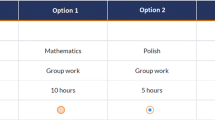Abstract
Learning to prioritize different activities effectively can help many students to become more efficient towards their work, managing time, energy, and stress. This paper presents an automated tool that helps students and teaches them how, as a team, can prioritize group work. The tool is based on a formal prioritization mechanism that encompasses a model and related process that takes into account the relative importance of each activity from each individual of the group. From individual judgment, the tool works out a prioritized list that reflects the group prioritization. The model is based on a sound mathematical basis to provide the automated support for the prioritization process that will be conducted by each team member while keeping the subjective viewpoint of each member. As a final step, the tool automatically computes the group final prioritized list of activities that reflects the team consensus.
Access this chapter
Tax calculation will be finalised at checkout
Purchases are for personal use only
Similar content being viewed by others
References
NourRazia et al.: A comparative study for prioritization techniques. In: the 1st Informatics Conference (ICF – 2015), 27–29 November 2015, Port Dickson, Negeri Sembilan, Malaysia (2015)
Gosenheimer, C.: Project prioritization: a structured approach to working on what matters most. University of Wisconsin System Board of Regents (2012)
Group Study: Making it Work for You. Carnegie Mellon University Academic Development. www.cmu.edu/acadev. Accessed 01 May 2016
Effective Decision Making in Teams. http://www.foundationcoalition.org/teams. Accessed 18 Apr 2016
Berander, P., Andrews, A.: Requirements prioritization. In: Aurum, A., Wohlin, C. (eds.) Engineering and Managing Software Requirements, pp. 69–94. Springer, Berlin (2005)
Waters, K.: Prioritization using MoSCoW. http://www.allaboutagile.com/prioritization-using-moscow/. Accessed 11 Apr 2016
Baer, D.: Dwight Eisenhower nailed a major insight about productivity. Business Insider (2014). http://www.businessinsider.com/dwight-eisenhower-nailed-a-major-insight-about-productivity-2014-4. Accessed 28 Mar 2015
“Action Priority Matrix” an e-book published by MIND Tools Limited (2009). http://inspiredindividuals.org/wp-content/uploads/2012/06/Time-Management-Toolkit2.pdf. Accessed 10 May 2016
Karlsson, J., Wohlin, C., Regnell, B.: An evaluation of methods for prioritizing software requirements. Inf. Softw. Technol. 39(14–15), 939–947 (1998)
Avesani, P., Bazzanella, C., Perini, A., Susi, A.: Facing scalability issues in requirements prioritization with machine learning techniques. In: Proceedings of 13th IEEE International Conference on Requirements Engineering, pp. 297–305 (2015)
Karlsson, J., Ryan, K.: A cost-value approach for prioritizing requirements. IEEE Softw. 14, 67–74 (1997)
Jawale, B., Bhole, A.T.: Adaptive fuzzy hierarchical cumulative voting: a novel approach toward requirement prioritization. Int. J. Res. Eng. Technol. 4(5), 365–370 (2015)
Saaty, T.L.: The analytic hierarchy process. NY, McGraw-Hill, New York (1980)
Aaqib Iqbal, Farhan, M. Khan, Shahbaz, A. Khan, “A Critical Analysis of Techniques for Requirement Prioritization and Open Research Issues.” International Journal of Reviews in Computing. Vol. 1., 2009
Saaty, T.L.: Decision making with the analytic hierarchy process. Int. J. Serv. Sci. 1(1), 83–98 (2008)
Danesh, S., Ahmad, R.: Study of prioritization techniques using students as subjects. In: Proceedings of the 2009 International Conference on Information Management and Engineering, ICIME 2009, pp. 390–394. IEEE Computer Society, Washington, DC (2009)
Hatton, S.: Early prioritisation of goals. In: Hainaut, J.-L. (ed.) ER 2007. LNCS, vol. 4802, pp. 235–244. Springer, Heidelberg (2007). doi:10.1007/978-3-540-76292-8_29
Firesmith, D.: Prioritizing requirements. J. Object Technol. 3(8), 35–47 (2004)
Herrmann, A., Daneva, M.: Requirements prioritization based on benefit and cost prediction: an agenda for future research. In: Proceedings of the 16th IEEE International Requirements Engineering Conference, pp. 125–134 (2008)
Khari, M., Kumar, N.: Comparison of six prioritization techniques for software requirements. J. Global Res. Comput. Sci. 4(1), 38–43 (2013)
Ramzan, M., Jaffar, M.A., Shahid, A.A.: Value based intelligent requirement prioritization (Virp): expert driven fuzzy logic based prioritization technique. Int. J. Innov. Comput. Inf. Control 7(3), 1017–1038 (2011)
Thakurta, R.: A framework for prioritization of quality requirements for inclusion in a software project. Softw. Qual. J. 21(4), 573–597 (2013). Springer
Saranya, B., Subha, R., Palaniswami, S.: A survey on prioritization methodologies to prioritize non-functional requirements. Int. J. Comput. Sci. Bus. Inf. 12(1), 32–44 (2014)
Zajarosova, M.: CRM factors assessment using analytic hierarchy process. In: Proceedings of 2nd International Conference on Education and Social Sciences, INTCESS 2015, 2–4 February 2015, Istanbul, Turkey, pp. 641–647 (2015)
Badri, M., Al Qubaisi, A., Mohaidat, J., Al Dhaheri, H., Yang, G., Al Rashedi, A., Greer, K.: An analytic hierarchy process for school quality and inspection. Int. J. Educ. Manag. 30(3), 437–459 (2016)
Norddin, N., Ahmad, N., Yusof, Z.M.: Selecting best employee of the year using analytical hierarchy process. J. Basic Appl. Sci. Res. 5(11), 72–76 (2015)
Author information
Authors and Affiliations
Corresponding author
Editor information
Editors and Affiliations
Rights and permissions
Copyright information
© 2017 Springer International Publishing AG
About this paper
Cite this paper
Ibrahim, O., El-Seoud, M.S.A. (2017). Towards Formally Prioritizing the Activities of Group Course Work Inside Student Teams. In: Auer, M., Guralnick, D., Uhomoibhi, J. (eds) Interactive Collaborative Learning. ICL 2016. Advances in Intelligent Systems and Computing, vol 545. Springer, Cham. https://doi.org/10.1007/978-3-319-50340-0_17
Download citation
DOI: https://doi.org/10.1007/978-3-319-50340-0_17
Published:
Publisher Name: Springer, Cham
Print ISBN: 978-3-319-50339-4
Online ISBN: 978-3-319-50340-0
eBook Packages: EngineeringEngineering (R0)




